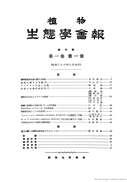Volume 3, Issue 1
Displaying 1-23 of 23 articles from this issue
- |<
- <
- 1
- >
- >|
-
Article type: Cover
1953 Volume 3 Issue 1 Pages Cover1-
Published: August 20, 1953
Released on J-STAGE: August 10, 2017
Download PDF (33K) -
Article type: Cover
1953 Volume 3 Issue 1 Pages Cover2-
Published: August 20, 1953
Released on J-STAGE: August 10, 2017
Download PDF (33K) -
Article type: Appendix
1953 Volume 3 Issue 1 Pages App1-
Published: August 20, 1953
Released on J-STAGE: August 10, 2017
Download PDF (99K) -
Article type: Article
1953 Volume 3 Issue 1 Pages 1-7
Published: August 20, 1953
Released on J-STAGE: August 10, 2017
Download PDF (1815K) -
Article type: Article
1953 Volume 3 Issue 1 Pages 8-13
Published: August 20, 1953
Released on J-STAGE: August 10, 2017
Download PDF (674K) -
Article type: Article
1953 Volume 3 Issue 1 Pages 14-16
Published: August 20, 1953
Released on J-STAGE: August 10, 2017
Download PDF (369K) -
Article type: Article
1953 Volume 3 Issue 1 Pages 17-23
Published: August 20, 1953
Released on J-STAGE: August 10, 2017
Download PDF (712K) -
Article type: Article
1953 Volume 3 Issue 1 Pages 24-31
Published: August 20, 1953
Released on J-STAGE: August 10, 2017
Download PDF (972K) -
Article type: Article
1953 Volume 3 Issue 1 Pages 32-37
Published: August 20, 1953
Released on J-STAGE: August 10, 2017
Download PDF (561K) -
Article type: Article
1953 Volume 3 Issue 1 Pages 38-46
Published: August 20, 1953
Released on J-STAGE: August 10, 2017
Download PDF (909K) -
Article type: Article
1953 Volume 3 Issue 1 Pages 47-49
Published: August 20, 1953
Released on J-STAGE: August 10, 2017
Download PDF (302K) -
Article type: Appendix
1953 Volume 3 Issue 1 Pages 49-
Published: August 20, 1953
Released on J-STAGE: August 10, 2017
Download PDF (62K) -
Article type: Article
1953 Volume 3 Issue 1 Pages 50-
Published: August 20, 1953
Released on J-STAGE: August 10, 2017
Download PDF (219K) -
Article type: Article
1953 Volume 3 Issue 1 Pages 50-
Published: August 20, 1953
Released on J-STAGE: August 10, 2017
Download PDF (219K) -
Article type: Article
1953 Volume 3 Issue 1 Pages 51-
Published: August 20, 1953
Released on J-STAGE: August 10, 2017
Download PDF (218K) -
Article type: Article
1953 Volume 3 Issue 1 Pages 51-
Published: August 20, 1953
Released on J-STAGE: August 10, 2017
Download PDF (218K) -
Article type: Article
1953 Volume 3 Issue 1 Pages 51-52
Published: August 20, 1953
Released on J-STAGE: August 10, 2017
Download PDF (352K) -
Article type: Article
1953 Volume 3 Issue 1 Pages 52-
Published: August 20, 1953
Released on J-STAGE: August 10, 2017
Download PDF (179K) -
Article type: Article
1953 Volume 3 Issue 1 Pages 52-
Published: August 20, 1953
Released on J-STAGE: August 10, 2017
Download PDF (179K) -
Article type: Article
1953 Volume 3 Issue 1 Pages 52-
Published: August 20, 1953
Released on J-STAGE: August 10, 2017
Download PDF (179K) -
Article type: Appendix
1953 Volume 3 Issue 1 Pages App2-
Published: August 20, 1953
Released on J-STAGE: August 10, 2017
Download PDF (90K) -
Article type: Index
1953 Volume 3 Issue 1 Pages Toc1-
Published: August 20, 1953
Released on J-STAGE: August 10, 2017
Download PDF (36K) -
Article type: Index
1953 Volume 3 Issue 1 Pages i-iv
Published: August 20, 1953
Released on J-STAGE: August 10, 2017
Download PDF (271K)
- |<
- <
- 1
- >
- >|
